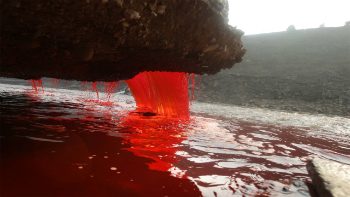This phenomenon is full of oddities
When British geographer Thomas Griffith Taylor embarked on his daring journey across East Antarctica in 1911, his expedition encountered a terrifying sight: the edge of a glacier with a stream of blood flowing from it. After a century of speculation, the cause of Blood Falls has been established.
US scientists used powerful transmission electron microscopes to analyze samples of Blood Falls water and found an abundance of iron-rich nanospheres that turn red when oxidized.
“As soon as I looked at the microscope images, I noticed that there were these little nanospheres, and they were rich in iron, and besides iron, there were many different elements in them – silicon, calcium, aluminum, sodium – and they were all different,” he said in a statement Ken Leavy, a research scientist in the Department of Materials Science and Engineering at the Whiting School at Johns Hopkins University.
Known for its deep red color, iron oxide has until now been a prime suspect in the Blood Falls mystery. However, this advanced imaging technique has helped researchers gain a clearer picture of why the seeping waters are such a bright red hue — and why some previous studies have failed.
“For it to be a mineral, the atoms have to be arranged in a very specific, crystalline structure. These nanospheres are not crystalline, so the methods previously used to study solids do not detect them,” explains Livy.
One might assume that its blood-red waters are the most unusual feature of Antarctica’s Blood Falls, but this geological feature is full of oddities.
Scientists have determined that the red water that seeps from Blood Falls originates from a salt lake that has remained locked in ice for 1.5 to 4 million years. In fact, this lake is only part of a much larger underground system of hypersaline lakes and aquifers.
Analysis of the water shows that a rare subglacial ecosystem of bacteria lives in the buried reservoirs of hypersaline water – despite the almost complete absence of oxygen. This means that the bacteria persisted for millions of years without photosynthesis and were probably sustained by cycling iron from the brine.
Given these otherworldly properties, scientists believe that Blood Falls can be studied to gain a deeper understanding of other planets in other parts of the solar system.
“With the advent of the rover missions, there was interest in trying to analyze the solids coming out of the waters of Blood Falls as if it were a Martian landing pad,” says Leavy.
“What would happen if a rover landed in Antarctica? Would it be able to determine what caused Blood Falls to turn red? This is a fascinating question that several researchers have pondered.”
Source: iflscience.com









